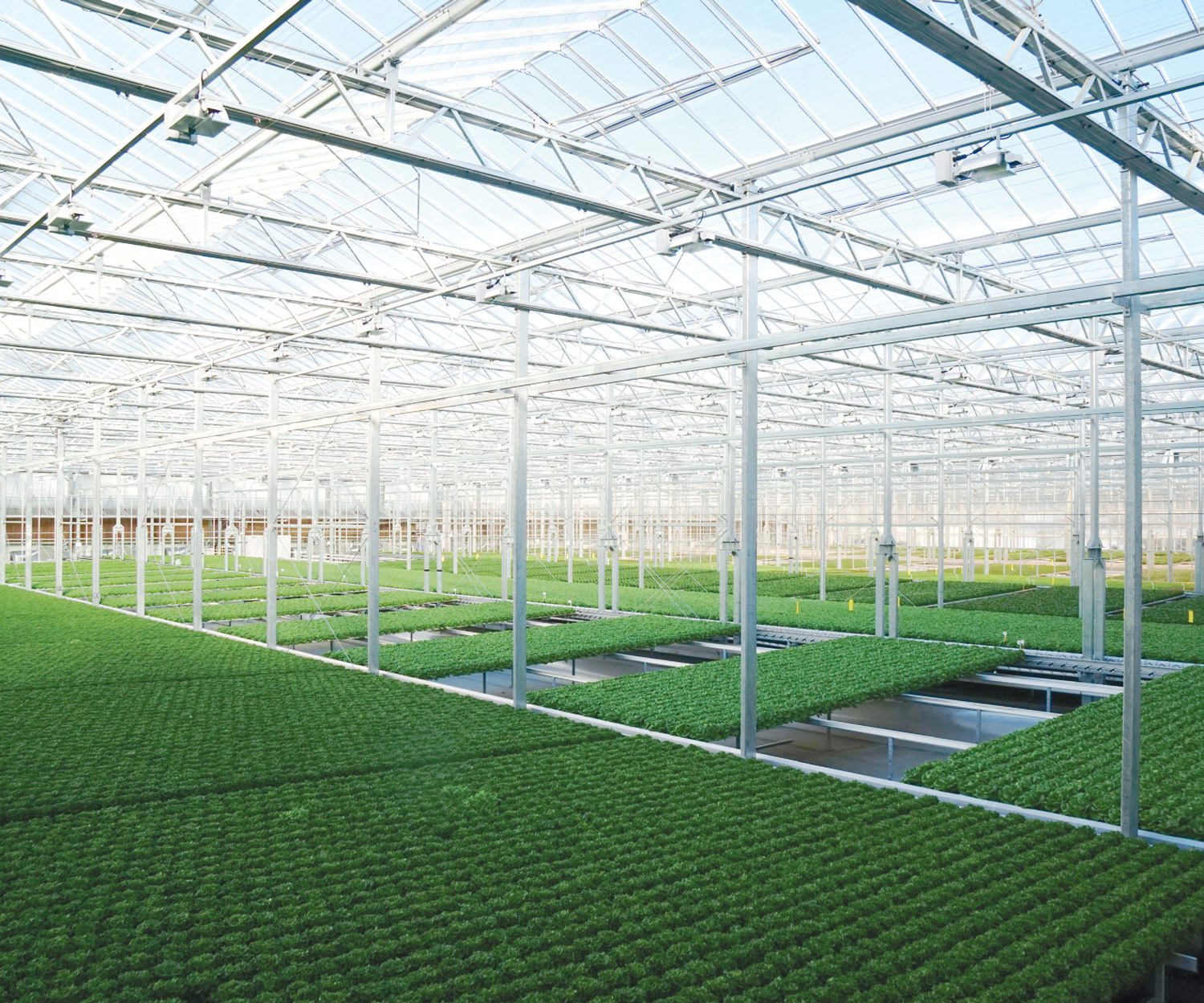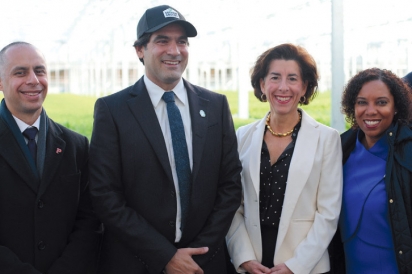Gotham Greens Comes to Providence’s Olneyville Neighborhood
Where Innovative Food Production Is Saving Salad From a 3,000-Mile Ride
Purchasing supermarket lettuce can sometimes be a risky business: Last year’s E. coli-contaminated romaine lettuce grown in California left tens of thousands of consumers, including Rhode Islanders, scrambling for safer alternatives. Such contaminations, says Viraj Puri, Gotham Greens co-founder and chief executive officer, underscore the benefits of consuming locally grown, readily traceable greens, such as those grown in Gotham Greens’ sterile and soil-free greenhouses.
Some 95% of salad greens sold in the U.S. are domestically grown in California and Arizona, and shipping salad greens from the West Coast to Rhode Island takes a full week, says Puri. “Those greens, which may experience food safety, sustainability and nutrition challenges, don’t stay fresh for long. In contrast, we [Gotham Greens] get products into the stores within 24 hours of harvest, 365 days a year.”
Now, Rhode Islanders can purchase salad greens and fresh basil grown by Gotham Greens in its new 100,000-square-foot hydroponic greenhouse. Consumers can choose from 10 varieties of lettuce including arugula, baby butterhead, Gourmet Medley and others (plus basil) that are all delivered to retail and restaurant customers within hours of harvesting; the leafy greens from Olneyville are being sold in markets from Connecticut to Maine. Lettuces grown and packaged in their new facility in Olneyville can currently be found locally at Dave’s Fresh Marketplace locations, Shaw’s, Star Market and Whole Foods Markets. The company also produces several bottled salad dressings made with its freshly grown herbs.
About the size of two NFL football fields, the new greenhouse, at 555 Harris Ave. in the capital city’s Olneyville neighborhood, is a 100% renewable-electricity-powered facility using 95% less water and 97% less land than conventional farming. The $13 million project received $200,000 from the Providence Redevelopment Agency and $250,000 from the Rhode Island Department of Environmental Management (DEM); Gotham Greens will receive up to $2 million in state tax credits over 10 years and should meet its target of 60 fulltime jobs.
The company expects to employ up to 60 people possessing a wide range of skills, from entry-level to highly skilled individuals with advanced degrees. For entry-level jobs, Gotham Greens pays 20% above minimum wage in its Providence facility, plus benefits. Providence City Council President Sabina Matos, who represents Olneyville and parts of the Silver Lake and Valley neighborhoods, says, “This opens up opportunities for a wide range of my constituents to be able to apply [for positions there].”
“Gotham Greens in Providence will produce more than 6 million heads of leafy greens each year for the local New England market,” says Puri, who expressed appreciation for the broad-based support Gotham Greens received from a wide array of public and private-sector entities. “This business wouldn’t work if it weren’t for the vision and innovation of our retail partners who also must have a vision about disrupting the whole supply chain of delivering fresh produce,” Puri adds.
After identifying New England as a potential market, Puri asserts that Providence rose to the top of the list of prospective locations quite quickly. “From our first visit here … the support was overwhelming and it felt like the right place to be.” In addition to its commitment to regularly donate fresh greens to Amos House and Rhode Island Community Food Bank, Gotham Greens has donated a portion of its land for a publicly accessible bike path along the Woonasquatucket River.
Providence is not Gotham Greens’ first rodeo; the privately held company opened three greenhouses in New York starting in 2011 (their first two in Brooklyn), followed by two in Chicago. After Gotham Greens opened in Providence in December 2019, the company opened a greenhouse in Baltimore, Maryland. Another in Denver, Colorado, is going online in spring 2020; plans for additional yet-to-be- disclosed locations across the country are underway.
These greenhouses are well-built, too; a tour guide leading Governor Gina Raimondo, Mayor Jorge Elorza and other community leaders through the Olneyville facility at the December opening ceremony explained that the company’s two New York–based greenhouses built before Hurricane Irene (August 2011) and Hurricane Sandy (October 2012) withstood both fierce storms.
Some members of the community have expressed concerns that the arrival of Gotham Greens in Providence could negatively impact local farms like Four Town Farm and Confreda Greenhouses & Farms, or smaller venues like Wishing Stone Farm and Baby Greens.
“Though they are creating jobs in a depressed area of the city, Gotham Greens enjoys a disproportionate advantage over the local agricultural community because of tax incentives and stimulus funding,” says Skip Paul of Wishing Stone Farm, an organic farm in Little Compton. “Their target market of greens and herbs is going to take away from the income stream of small startup farms by flooding markets with the very product small farms need for their early survival, as well as locking small growers out of opportunities to service wholesale accounts or restaurants in the area.”
Gotham Greens recognizes that it is part of a larger eco-system with many types of agriculture, says DEM Chief of Agriculture Ken Ayars. “Most Rhode Island produce is extremely seasonal; relatively few farmers here are selling [fresh-picked greens] in the winter months,” says Ayars, who notes that Gotham Greens’ lettuces will be sold into retail supermarkets and institutional venues, in contrast to Rhode Island’s hundreds of small farmers selling at farm stands and farmers markets.
Since only 1 to 2% of food that is consumed in Rhode Island is actually grown here, Ayars anticipates that Gotham Greens could increase that percentage. “It’s still true that New England is highly dependent on food moving to us from thousands of miles away … and Gotham Greens is a big part of moving to more locally based and sustainable [food sources],” says Ayars. “There are other likeminded businesses here that are glad for this momentum … I think we’ll see more of that in Rhode Island.”
The Gotham Greens greenhouse in Olneyville was built on land that had been vacant for nearly 20 years after General Electric closed its manufacturing plant along with hundreds of jobs. “That represented 20th century manufacturing,” says Puri. “I’m really proud that what we’re doing here represents a transformation to 21st century clean, green manufacturing.”
“I’ve long had a vision for the Olneyville and Valley area that it will become a STEM [Science, Technology, Engineering and Math] hub, and it’s been happening organically, with a bit of a push,” says Council President Matos. “I think that this modern way of producing food fits in perfectly with everything else happening in this area … Farm Fresh Rhode Island will be opening down the street—there’s good and positive energy for new technology coming to the neighborhood.”
Working in Africa and India on clean technology solutions for several years led Puri to realize agriculture’s huge impact on climate change. After discovering that agriculture is the largest consumer of Earth’s fresh water supply, the leading cause of global water pollution and contributes 20% of carbon emissions, Puri believes that any serious efforts to address climate change must include agriculture’s huge impact on the environment. By marrying hydroponic greenhouse technology that uses far less land and water than do conventional farms, with the growing demand for transparency and locally grown food, brand loyalty for such goods may develop.
“Our vision was to locate greenhouses in urban areas … more than 70% of the U.S. population live in cities and are disconnected from how food is grown.
“I welcome competition; more and more people are [growing] leafy greens in greenhouses,” including in neighboring Massachusetts, Puri says. “Indoor-grown produce, especially leafy greens and lettuce, is less than 1% of the food supply chain and yet it’s a $14 billion market. There’s room for multiple winners; I would like to see more produce grown locally—and regionally.”
Will Gotham Greens add tomatoes or other veggies to its product mix? “We’re taking it one step at a time … we want to grow high-quality products for consumers and chefs who are buying these consistently best products that last in their fridge [and are] grown sustainably,” says Puri. “The company will only grow at a pace that will support that product quality and integrity.”
For more information, visit GothamGreens.com.






